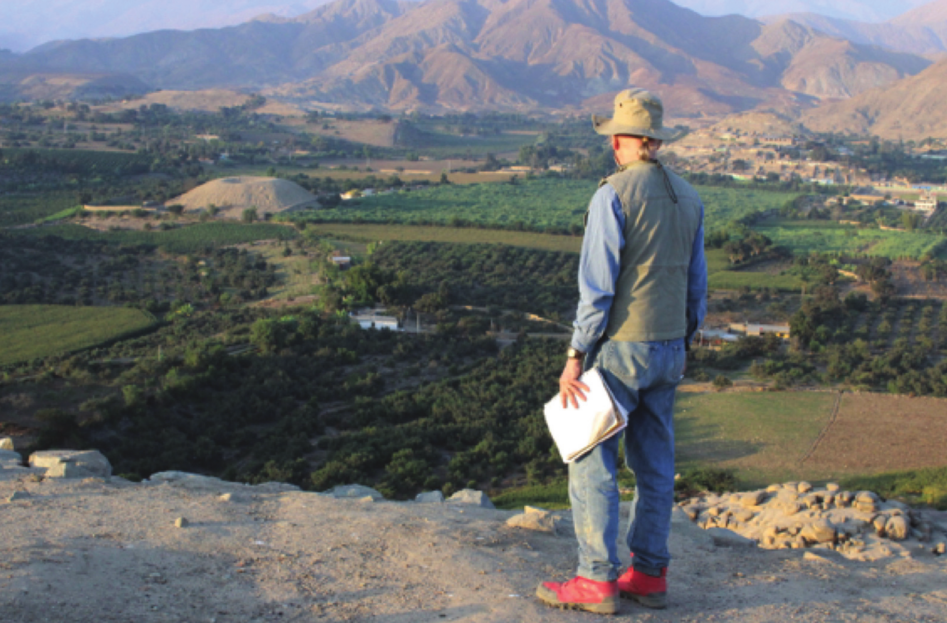Mysterious volcano-shaped pyramid discovered in Peru hosted celebrations in honour of solar eclipsesThe structure, known as El Volcán, was probably erected deliberately to look like a volcano.
International Business Times
By Léa Surugue Updated May 31, 2017 13:58 BST
 From a distance, the pyramid looks like a volcano.(Robert A. Benfer &Andrés Ocás/ Antiquity)
From a distance, the pyramid looks like a volcano.(Robert A. Benfer &Andrés Ocás/ Antiquity)A mysterious pyramid discovered in coastal Peru was built to resemble a volcano, archaeologists have suggested. It is possible that the structure was used to host ceremonies linked to major astronomical events, such as eclipses.
In the 1960s, archaeological work conducted in Peru's Nepeña Valley had revealed the existence of an artificial earth mound, more than 15 metres high.
Although it wasn't clear who had erected it and when, researchers quickly became fascinated with this pyramid – especially since from a distance it looked very much like a volcanic cinder cone. This resemblance led them to call the structure El Volcán.
Despite having been discovered more than five decades ago, El Volcán is only now starting to reveal its secrets. In-depth excavations have begun only recently, and the first findings are now
published in the journal Antiquity.
Building a volcano
The exact date of the pyramid's construction is still unknown, but it is estimated to have been built sometime between 900 BCE and 200 BCE.
Among the most important questions that the archaeologists will attempt to answer over the course of their investigations is what activities took place at the site and whether the pyramid was deliberately made to look like a volcano or if other events shaped it in this way.
"Two main explanations have been put forward, one arguing that later looting or erosion has created the site's distinctive form, and the other that the site was originally constructed to resemble a volcanic cone and can be linked to astronomical events and ethnohistorical accounts," the authors of the paper write.
At this early stage in their investigations, they believe that the latter is more likely. Indeed, the theory that looters went through the structure does not hold, for a number of reasons.
 A cinder cone in the Andahua Valley, Peru compared compared with the pyramid of El Volcán in the Nepeña Valley.(Robert A. Benfer &Andrés Ocás/ Antiquity)
A cinder cone in the Andahua Valley, Peru compared compared with the pyramid of El Volcán in the Nepeña Valley.(Robert A. Benfer &Andrés Ocás/ Antiquity)This structure is a cone-shaped pyramid with a central pit at the top. Even if looters had created the central pit to enter the structure, this does not explain its conical shape. They would also have had to get rid of the soil, but the hypothetical volume of material that would have filled the central pit is 2135 cube metres – "an amount that would surely be visible if discarded down the exterior of the pyramid", the researchers point out.
And although the erosion theory is possible, it does not account for the internal cone structure found within El Volcán. "On present evidence, therefore, we conclude that the pyramid was originally and deliberately constructed in the form of a volcano – a cone-shaped pyramid with a central pit," the authors say.
Celebrating the eclipses
While many uncertainties remain, archaeologists have been able to find out when the pyramid was last occupied and this sheds light on what purpose it served.
A radiocarbon date for the El Volcán hearth has revealed the last occupation of the pyramid took place around 1563 CE. In the years leading up to it, a series of four total solar eclipses - one in 1521 CE, in 1538 CE, in 1539 CE and in 1543 CE - is thought to have occurred.
These astronomical phenomena would have called for great celebrations by the local populations who lived there at the time. "The people of the northern and central coasts, the Yungas, unlike the later Incas, greeted eclipse of the sun with joy, not fear. The median radiocarbon date of 1563 CE falls after a cluster of eclipses making it possible that a closing ceremony might have been linked to one of these eclipses".
The archaeologists think that the volcano-shaped pyramid may thus have been an important site to host major ceremonies in honour of eclipses and other astronomical phenomena.
http://www.ibtimes.co.uk/mysterious-volcano-shaped-pyramid-discovered-peru-hosted-celebrations-honour-solar-eclipses-1624111
![]() 6 new categories and 72 new items added to the shop!
6 new categories and 72 new items added to the shop!![]() 6 new categories and 72 new items added to the shop!
6 new categories and 72 new items added to the shop!